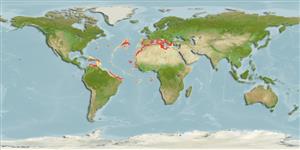Common names from other countries
Classification / Names / Names
Nomes comuns | Sinónimos | Catalog of Fishes (gen., sp.) | ITIS | CoL | WoRMS
Environment: milieu / climate zone / depth range / distribution range
Ecologia
; intervalo de profundidade 36 - 1935 m (Ref. 1821). Tropical
Western Atlantic, Caribbean: USA and Brazil. Eastern Atlantic: North Africa and Gulf of Guinea. Tropical to subtropical climates.
Length at first maturity / Tamanho / Peso / Idade
Maturity: Lm ? range ? - ? cm Max length : 5.0 cm SHL macho/indeterminado; (Ref. 3441)
Shell slightly curved, slender, white. Low primary ribs (15-20). Crossed by transversal lines giving an irregular aspect to the whole surface. Apex is simple or V- or U-shaped notch on convex side. Apical, oral sections subcircular.
Minimum depth from Ref. 111279. Infaunal (Ref. 111279).
Life cycle and mating behavior
Maturidade | Reprodução | Desova | Ovos | Fecundidade | Larvas
Members of the class Scaphopoda are gonochoric. Fertilization occurs in the mantle cavity. Life cycle: Eggs hatch into free-swimming lecithotrophic trochophore larvae, succeeded by shelled veligers.
Steiner, G. and A.R. Kabat. 2004. (Ref. 1821)
Categoria na Lista Vermelha da IUCN (Ref. 130435)
Categoria CITES (Ref. 108899)
Not Evaluated
Not Evaluated
Utilização humana
| FishSource |
Ferramentas
Mais informação
Nomes comunsSinónimosPredadoresReproduçãoMaturidadeDesovaFecundidadeOvosDesenvolvimento dos ovos
Idade/TamanhoCrescimentoComprimento-pesoComprimento-comprimentoMorfologiaLarvasAbundância
Fontes da internet
Estimates based on models
Preferred temperature
(Ref.
115969): 4.9 - 13.8, mean 11.4 (based on 231 cells).
Vulnerabilidade
Low vulnerability (10 of 100).
Categoria de preço
Unknown.
